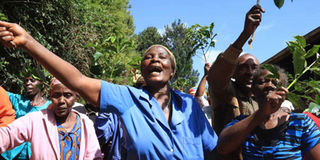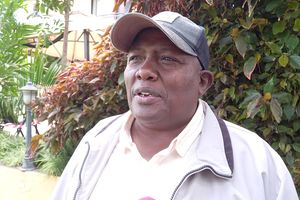Premium
Why Kenyan coffee farmers wallow in poverty as dealers make a killing

Coffee farmers protest outside Ndaroini factory in Nyeri County against the management of Gikanda coffee society, on January 14, 2019. Most coffee growers are poor small-scale farmers in developing countries spread across Africa, Southern America and Asia. PHOTO | FILE | NATION MEDIA GROUP
What you need to know:
- After the collapse of the quota system, it was free for all: Blood-sucking intermediaries and traders captured the market.
- Frustrations with the traditional system inspired organisations such as Oxfam and human rights groups to wage a campaign for an alternative trade based on values.
The International Coffee Organisation (ICO) council is in Nairobi to talk about how to improve standards and shorten the distance between farmer, roaster, barista and consumer; and so on.
The council has been talking about these issues since the coffee crisis began 30 years ago. These worthies will be staying in some refined hotels to the west of Tom Mboya Street.
Yet thousands of coffee farmers cannot afford food and school fees for their families.
Here are some truths about coffee that the council might want to ponder. Coffee is the second most traded commodity globally after oil.
Over 2.8 billion cups of coffee are consumed daily, mostly in developed countries.
Globally, about 250 million people depend on the coffee economy, among them about 20 million producers.
POVERTY
Most coffee growers are poor small-scale farmers in developing countries spread across Africa, Southern America and Asia.
The global coffee business is worth anything from $50 billion to $100 billion (Sh500 billion to Sh1 trillion), but less than one sixteenth of this reaches farmers.
Typically, coffee farmers are a hungry, angry, shoeless lot of peasants, unable to take their children to school. It has been getting worse in the past three decades.
Currently, Kenyan small-scale coffee farmers earn about $100 (Sh10,000) annually for their effort.
However, a family of six in coffee growing areas needs a minimum of Sh150,000 annually to survive.
And while the coffee farmer has been impoverished, profits for multinational coffee dealers have tripled and in some cases quadrupled.
CONTROL
Small-scale producers have endured slave prices for too long. “Coffee growers received the equivalent of six cents per cup in 1983 even if the cup was sold at anything from $1 to $5. Today, they receive less than two cents (about three shillings),” Mr Fernando Morales de la Cruz, the CEO of Coffee for Change, a pressure group that fights for better treatment of producers, said.
So, what happened? A deeper understanding of the coffee market chain is important to avoid false hopes. First, coffee is a highly internationalised commodity.
It was long globalised before the internet. Local cartels are just the tip of the iceberg, being an extension of an intricate maze that is the international coffee trade.
About seven multinationals control most of this trade in a system Mr Morales de la Cruz plainly calls typical neocolonialism.
In 1988, the International Coffee Agreement (ICA) collapsed. During coffee’s heyday, this protocol assigned market quotas to members.
QUOTA SYSTEM
For example, Kenya produced about 140,000 metric tonnes in the 1980s but could only sell about 50,000.
However, due to the popularity of its coffee, the country could easily sell the remainder to non-members of the ICO.
In fact, Kenyan coffee still enjoys a unique position in the world because of its unique taste. This system ensured that producers got some fair prices.
In fact, big producers like Brazil would even dump excess coffee into the sea just to stabilise the market.
After the collapse of the quota system, it was free for all: Blood-sucking intermediaries and traders captured the market.
There are three coffee marketing systems: The traditional market, fair trade and direct coffee trading.
MARKETING
Kenya uses the traditional system. After the auction in Nairobi, the coffee ends up in the New York Coffee, Sugar and Cocoa Exchange, where most Arabica coffee is offered.
Here, Kenya’s coffee is identified as Colombia Mild (C) type and fetches a premium price.
Most Robusta coffee, the kind grown in Uganda, called Brazilian Naturals, is traded at the London International Financial Futures and Options and earns less.
Now, the traditional coffee market trade is over 100 years old. Kenya is a critical source of high-grade coffee for blending other coffees.
The largest roasters do not deal with farmers directly but rely on traders for supply.
In Kenya, large trading companies are the likes of Neumann Gruppe (Germany), Volcafé (Switzerland) and ECOM (Switzerland). These three multinationals trade 50 per cent of the world’s green coffee.
FAIR TRADE
The traditional system has attracted much criticism in the past 20 years.
It is seen as detached and a classic example of the heartless international trade, with little interest in the welfare of the farmer.
Analysts say the main problem is that farmers lack the social, cultural and economic capital to influence the system, and being from poor countries they will remain price receivers.
NGOs such as Coffee for Change are calling for a parallel system that does not answer to the dictates of the New York and London exchanges. However, this is a gamble because consumer economies are in charge.
Frustrations with the traditional system inspired organisations such as Oxfam and human rights groups to wage a campaign for an alternative trade based on values.
This gave birth to the fair trade system that attempts to force multinationals to take more interest in the plight of poor farmers.
SACCOS
Under this system, farmers are required to meet certain conditions like being in a cooperative society.
Cooperatives have to meet quality standards and labour conditions as outlined by the International Labour Organisation.
Once done, the cooperative invites a certification agency for approval.
Driving this trend are highly informed consumers in the West, who increasingly demand to know how the coffee they drink is produced.
This is all in the spirit of sustainable development. Consumers are ready to pay more for coffee.
This extra pay is supposed to be channelled back to fair trade-compliant farmers.
Fearing the wrath of consumers, most global coffee companies quickly complied with fair trade rules. Inevitably, questions have emerged. How fair is ‘fair trade’?
DIRECT TRADE
International trade is structured around profit, and only profit. Ethics and fairness are in the religious department.
“Consumers are unaware that less than a third of the so-called fair trade premium reaches the farmer. People must know that this ‘ethical’, ‘sustainable’, and ‘fair’ certifications perpetuate poverty, which is unacceptable …” Morales de la Cruz says.
Frustrated by the capture of the fair trade initiative by big multinationals, some roasters started looking for ways of contacting producers directly. This gave birth to the third trading system — direct trade.
The best known companies in the direct trade system are in the US and sell to specialty and high-end niche markets, where a kilo of coffee could cost a bit more than a small saloon car.
The three pioneer companies in this system are Intelligentsia Coffee and Tea, Counter Culture Coffee and Stumptown Coffee Roasters.
“Direct trade is about relationships. A method of sourcing coffee based on its quality. It is about respect. Buyers travel the world to find the best coffee from the best farms. When they find it, they work directly with the farmer,” Direct Trade Coffee Club says on its website.
INNOVATE
Little can be done in the short term about international trade systems. Unless the gods strike Brazil’s, Colombia’s and Vietnam’s coffee with eternal frost, Kenyan growers will remain poor if they depend on the traditional market alone.
Innovation is necessary. Unlike Ethiopia where half of its coffee is sold in the country, we don’t have a coffee drinking culture.
Despite the issues facing the sector, Kenyan coffee still stands a good chance in niche markets.
The most important thing for Kenyan farmers is the high quality of their coffee.
Our cooperatives have a comparative advantage over other producers around the world because of well-established quality assurance practices.
Extension services are mostly dead but they can be reactivated.
Direct trade presents a distinctive chance for producers to receive better prices and establish a direct relationship with roasters, but cooperatives should be professionally managed for this to work.
The government should actively support the system.
Dr Mbataru teaches at Kenyatta University and is the author of The Coffee Crisis, Old Interests, New Interests and the Illusions of Development





